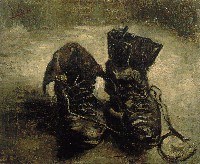August 23, 2003
Sontag: Regarding the Pain of Others#14+
Rick's project on Susan Sontag's Regarding the Pain of Others takes a sharp turn away from mutilated bodies, suffering, redemption and ecstasy. Rick does not cross the threshold into the world of Bataille that I opened up with the writings of Dirty Whore Online on sexuality, pain and redemption.
Instead we have this image:

Van Gogh, Still Life with Shoes
What to make of the turn in the face of the horrors?
Well Rick asks: Transfiguration: A change that glorifies or exalts. Is there suffering and exaltation in Van Gogh's shoes?
Maybe is the short answer. Suffering but not necessarily exaltation.
What we have is an art work in an institutional space where objects are given a certain status of art, that means little more than 'located in the art world.' This painting of the shoes of peasants is one of the works that the art institution happens to talk about.
Now that response leaves us empty, shortchanged and cheated. Surely we can say more than that, apart from talking about the paint, the technique or art history? That has the feeling of 'the end of art' scenario about it. A closure. Art is not saying anything significant about life anymore. Art is just about the slabs of paint on a canvas---the medium:
Gerhard Richter G. A. 4
Someone who thinks otherwise to this is Martin Heidegger. In an essay called The Origin of the Work of Art he sees the work of art in its material form and as connected to the earth. He argues that an art work has an ability to force a clearing in the everyday exchanges and happenings of existence. It has the capacity to open up a world. and to arrest our attention. it is also a slab of existence.
A slab of existence. That connects us to suffering and exaltation. What does that mean? That means reading Heidegger's The Origin of the Work of Art-----no easy task. But it is a crucial essay because Heidegger discusses this very painting by Van Gogh.
This essay basically says that art discloses a clearing. People often interpret this in terms of the wonder of art, the mysterious of art, if they can ever get beyond the Nazi politics.
The painting of shoes discloses the world of the peasant woman is more mundane. How so? Here is a paragraph from the essay that connects the materiality of the painting to the earth:
"From the dark opening of the worn insides of the shoes the toilsome tread of the worker stares forth. In the stiffly rugged heaviness of the shoes there is accumulated tenacity of her slow ytrudge through the far-spread and ever-uniform furrows of the field swept by a raw wind. On the leather lie the dampness and richnes of soil. Under the soles slides the loneliness of the field path as evening falls. In the shoes vibrates the silent call of the earth, its quiet gift of the ripening grain and its unexplained self-refusal in the fallow desolation of the wintry field."
And so on. What Heidgger does is show that this equipment (the shoes) belong to the earth and it is protected in the world of the peasant women.
Art discloses---not represents---- a world. As Heidegger puts it:
" Van Gogh's painting is the disclosure of what the equipment, the pair of peasant shoes, is in truth."
So do Mapplethorpe's S&M photos discloses a world.
That disclosure or unconcealedness is a disclosure (aletheia) of a particular being, a disclosing what and how it is. That disclosure is a happening of truth at world in the work of art.
There is certainly noble suffering the shoes ----it part of a world that is opened up--- but little by way of exaltation on Heidgger's account. The suffering and exaltation is more a Bataille theme.
Posted by Gary Sauer-Thompson at August 23, 2003 08:30 PM | TrackBack